How did you get into photography, what schools did you attend and what drives you and motivates you to continue this research.
Louis Porter (LP): I can’t remember exactly when I developed an interest in photography, but by the time I was 18, I was taking photographs with increasing frequency and had setup the first of many darkrooms. I began and left two university courses and although one of them was in photography, I think it’s probably more accurate to say I am self-educated. I began making a living from photography in my mid twenties and in 2003 I embarked on a series of long-term photographic projects.

© Louis Porter, ‘Cheap Flights’ from Fun
I am an inveterate wanderer, both in my interests and movements and I believe this tendency instigated my involvement with photography. Like many, I am motivated by a desire to describe the world, how it works and why. In order to do this, some form of mediation is required: language, science, faith and so on. Any act of encapsulation, ultimately envelops the subject in its own representation, a kind of metaphysical bait and switch. What began as a simple act, the desire to “collect” fragments of the world, has evolved into a fascination in the effect the process of collecting and collating has on reality. Therefore, much of my drive to photograph has been generated from the photographs I have already made.
Let’s talk about landscape or human geography. A recurring theme, that crosses many of your works. What attracts us is the curiosity with which you deal with this research. The series, or rather the archive, 'The Small Conflict Archive’, is a collection of practices and urban behavior from which emerge several aspects of everyday life both social and anthropological. A project that also masks a desire to realize and enhance what is 'already there’ but not seeing anymore (Rupture and Repair, Crap Paint Jobs, Men Up Ladders…) Tell us a bit more of it and also what are the plans for this archive that we hope you will keep growing in the future.
LP: There is a common assumption that in the performance of the everyday, the expected and ordinary, there exists a natural equilibrium, a normality that we consider to be the correct state of being. It is this framework of normality that we see broken or shattered by acts of violence, such as assault and murder. The Small Conflict Archiveproposes that acts of violence are not simply deviations from a stable norm, but part of an arrangement of varying shades of conflict, of which normality makes up the majority.
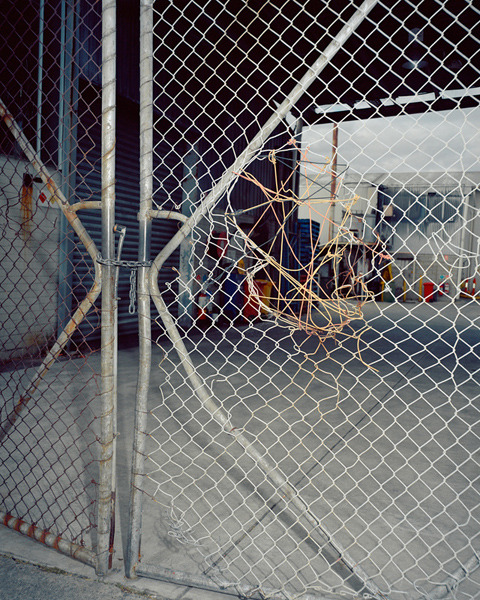
© Louis Porter, 'Rupture and Repair’ from The Small Conflict Archive
To the Archive, the surface of a city is made up of vast networks of signification, but because of the sheer quantity of information we are confronted with, our minds treat this visual cacophony as a form of optical “elevator music”. Much as a scientist uses a prism to diffract light, I’m trying to use photography to break down the surface of the city, to reveal the hidden connections.
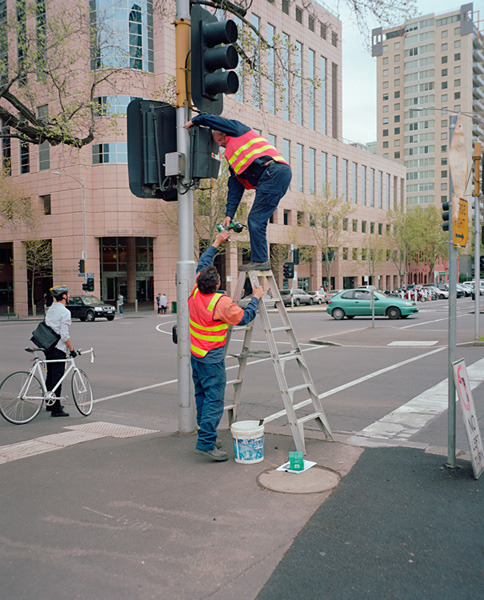
© Louis Porter, 'Men Up Ladders’ from The Small Conflict Archive
I very much see the project as ongoing and a selection of the work is being published early next year under my imprint Twenty Shelves, with the support of the Victorian Equal Opportunities and Human Rights Commission.

© Louis Porter, 'Bodge’ from The Small Conflict Archive
Some of your projects use the memory, for example through the use of historical images, or archive. As in the series 'The Anatomy of Business’ or 'Record and Analysis’ for instance. Tell us briefly about these works, and above all, how important is the size of time in your narrative.
LP: Both “The Anatomy of Business” and “Record and Analysis” involve the appropriation of a pre-existing archive and the addition of photographs produced by myself, in response. The final projects are presented in such a way, that the context and authorship of the images are brought into question.

© Louis Porter from The Anatomy of Business
The writer Jorge Luis Borges, suggested that the history of literature could be told without referring to individual authors and that what we see in literature are metaphors and ideas that thread in and out of history. I think this can also be said of photography and my archival projects forgo the: who, why, what and when, to attempt an examination of the structure of the message, to look for continuity in the photographic act, in its gestures and motifs. Time is fundamental to photography, but it is always the present that mediates our understanding of the past, so that any historical record, such as a photograph, is hermetically sealed the moment we look at it. With these projects, I have attempted to break this seal by fracturing the very things that make these photographs unique, their context and in particular with the “Anatomy of Business”, their source.

© Louis Porter from The Anatomy of Business
Going back to the urban landscape, we find that you often have recourse to a vernacular attention to highlight what you call 'cracks’, as in the series 'Unknown Land’. Why is it important to tell the country in this way, and what draws you to it?
LP: Australia could be viewed as an example of the “transportation of place”, the imposition of the social, cultural and physical characteristics of one place (Europe) onto another (Australia). Although the continent was made up of hundreds of socially and linguistically distinct nations, forged over many millennia, it was considered by the British government to be Terra Nullius (land belonging to no-one) and treated as such.
In light of this, it becomes difficult to view the urban landscape, without addressing a process of colonial erasure. The “cracks” I am interested in, could be equated to the “tell” of the poker player, the twitch or curled lip that gives the game away. These, like the poker player’s involuntary tic, do not show what is being concealed, but demonstrate that an act of concealment is taking place. My intent with “Unknown Land”, is to produce a series of images that illuminate a sense of disquiet in the Australian Landscape, without directly revealing the source of the sensation.
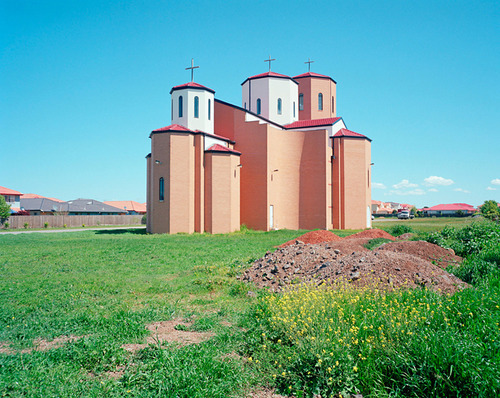
© Louis Porter from Unknown Land
There is a very mysterious quality to the Australian urban landscape; at times it can feel like being on a film set before the actors arrive for work. I find this feeling, from an artistic perspective, deeply compelling.
Some series tell us about Chinese and China. Recently, the Chinese landscape photography is becoming a little cliché. In your images instead we find more curiosity (100 Flowers, Wires at Night) and less willing to judge. Images that raise questions rather than answers. What attracts you to this country, what has struck you in particular and what would you like to see again?
LP: China is a remarkably complicated country and one that for the most part, is very easy to photograph in. I have worked in China as both a professional photographer and an artist and the more I see of the country, the more complicated it appears to me. The temptation to photograph China in an exotic, industrial-picturesque fashion is understandable.
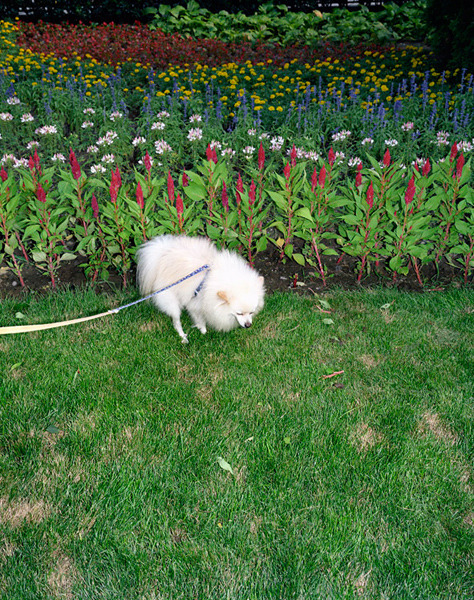
© Louis Porter '100 Flowers’ from I love China
However, although the massive factories and imposing concrete skylines certainly exist, they tell us no more about the country, than photographs of the Statue of Liberty and the Whitehouse tell us about America. It is in fact almost impossible to really get to grips with a country as a visitor, and all we can ever engage with is the surface of a place.
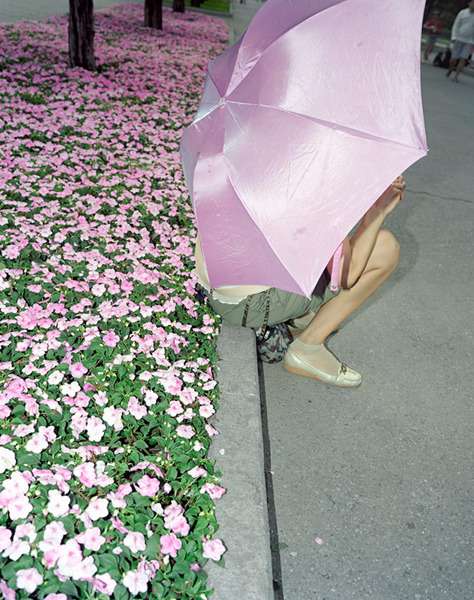
© Louis Porter '100 Flowers’ from I love China
To counter this, the projects I have produced in China, all engage directly with the engineered surface itself, be it the Olympic flowerbed decorations of 100 Flowers or the theme parks, shopping centres and museums of I Love China So Do You. What attracts me most to China, is it that it is simultaneously a society that appears to be in constant flux and yet almost without flinching, bears the weight of thousands of years of history. As with most of my work, I have tried in China to produce projects that have several layers. The title 100 Flowers for example, is a reference to a campaign initiated by Chairman Mao Zedong in 1956, where he called for the opinions of the Chinese intelligentsia on the revolution’s achievements. The far from glowing report led to a crackdown, that in turn germinated the Cultural Revolution.
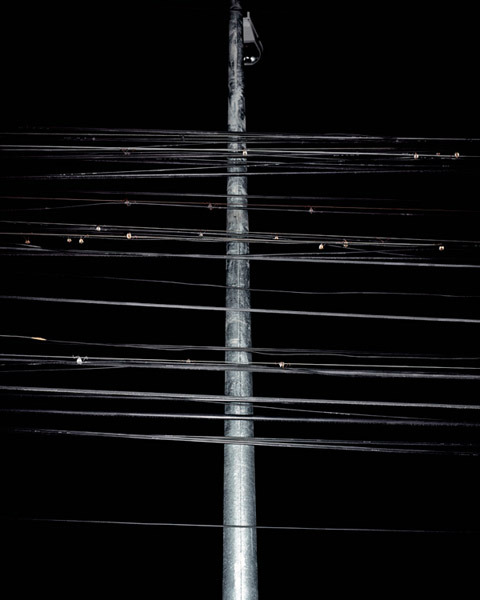
© Louis Porter 'Wires at Night’ from I love China
Finally, can you suggest to our readers a recent show, artist, book, movie that you particularly loved?
LP: Walid Raad’s exhibition/performance at Documenta 13, Scratching on Things I Could Disavow - A History of Art in the Arab World blew me away. Also the exhibition at the V&A of work by Arthur Bispo do Rosário, a Brazilian psychiatric patient and “outsider artist” was some of the best work I’ve seen.
---
LINKS
Louis Porter
Australia
share this page